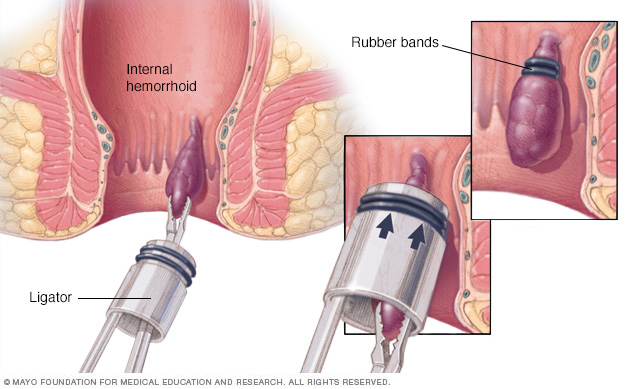HEMORRHOID TREATMENTS

HEMORRHOID TREATMENTS
Most of the time, treatment for hemorrhoids involves steps that you can take on your own, such as lifestyle modifications. But sometimes medications or surgical procedures are necessary.
To remove a hemorrhoid using rubber band ligation, your doctor inserts a small tool called a ligator through a lighted tube (scope) in the anal canal and grasps the hemorrhoid with forceps. Sliding the ligator's cylinder upward releases rubber bands around the base of the hemorrhoid. Rubber bands cut off the hemorrhoid's blood supply, causing it to wither and drop off.
MINIMALLY INVASIVE PROCEDURES
If a blood clot has formed within an external hemorrhoid, your doctor can remove the clot with a simple incision, which may provide prompt relief.
For persistent bleeding or painful hemorrhoids, your doctor may recommend another minimally invasive procedure. These treatments can be done in your doctor's office or other outpatient setting.
-
Rubber band ligation:
Your doctor places one or two tiny rubber bands around the base of an internal hemorrhoid to cut off its circulation. The hemorrhoid withers and falls off within a week. This procedure — called rubber band ligation — is effective for many people. - Hemorrhoid banding can be uncomfortable and may cause bleeding, which might begin two to four days after the procedure but is rarely severe.
-
Injection (sclerotherapy):
In this procedure, your doctor injects a chemical solution into the hemorrhoid tissue to shrink it. While the injection causes little or no pain, it may be less effective than rubber band ligation. -
Coagulation (infrared, laser or bipolar):
Coagulation techniques use laser or infrared light or heat. They cause small, bleeding, internal hemorrhoids to harden and shrivel. While coagulation has few side effects, it's associated with a higher rate of hemorrhoids coming back (recurrence) than is the rubber band treatment.
SURGICAL PROCEDURES
If other procedures haven't been successful or you have large hemorrhoids, your doctor may recommend a surgical procedure. Surgery can be performed on an outpatient basis or you may need to stay in the hospital overnight.
Compared with hemorrhoidectomy, however, stapling has been associated with a greater risk of recurrence and rectal prolapse, in which part of the rectum protrudes from the anus. Talk with your doctor about what might be the best option for you.
-
Hemorrhoid removal.
During a hemorrhoidectomy, your surgeon removes excessive tissue that causes bleeding. Various techniques may be used. The surgery may be done with a local anesthetic combined with sedation, a spinal anesthetic or a general anesthetic. -
Hemorrhoidectomy
is the most effective and complete way to treat severe or recurring hemorrhoids. Complications may include temporary difficulty emptying your bladder and urinary tract infections associated with this problem.
Most people experience some pain after the procedure. Medications can relieve your pain. Soaking in a warm bath also may help. -
Hemorrhoid stapling.
This procedure, called stapled hemorrhoidectomy or stapled hemorrhoidopexy, blocks blood flow to hemorrhoidal tissue. Stapling generally involves less pain than hemorrhoidectomy and allows an earlier return to regular activities.
Make an Appointment